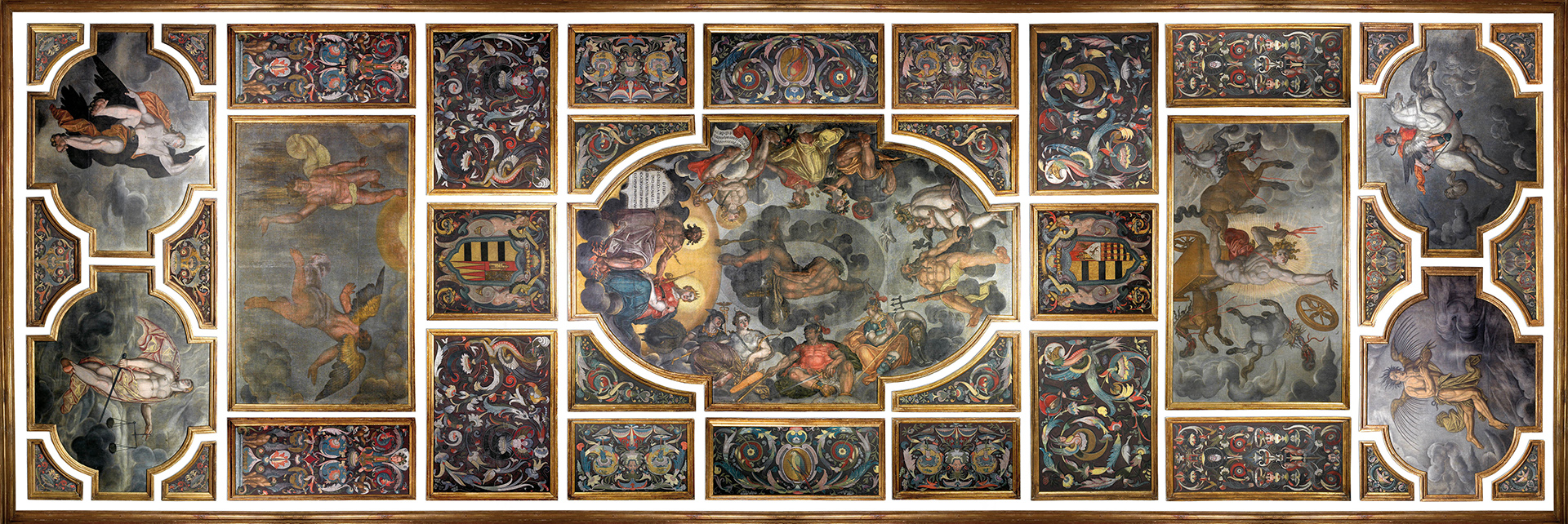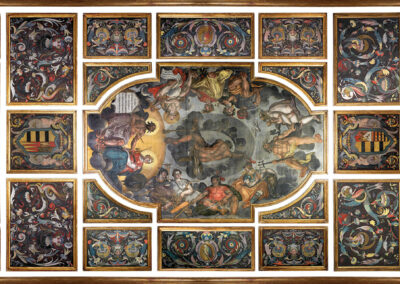Among the many works of art housed in the Casa de Pilatos, one of the most remarkable is the ceiling painted by Francisco Pacheco, master and father-in-law of Diego Velázquez, in the room that originally bore the name of "Camarín Grande" and is now called "Salón Pacheco". This is a long, narrow room built for the (3rd) Duke of Alcalá, together with other adjacent rooms, by the architect Juan de Oviedo in the first decade of the 17th century, and is covered with a flat ceiling formed by a wooden frame in which painted canvases are inserted.
The Pacheco ceiling is the second example of this type of ceiling that had no precedent in Seville; it was preceded by the one in the house of the poet Juan de Arguijo by two years and was followed shortly afterwards by the one in the main hall of the Archbishop's Palace. Thus, as far as we know, between 1601 and 1610 there were at least three important examples of a type of decorated ceiling hitherto unknown in the city and which was never to be repeated.
Significantly, the three commissioners - the poet Arguijo, a young (3rd) Duke of Alcalá with his adviser Francisco de Medina, and Cardinal Fernando Niño de Guevara - were known to each other and were part of the same humanist milieu in Seville. However, just as the ceilings of Juan de Arguijo's house and the Archbishop's Palace still present numerous unknowns as to authorship and meaning, Pacheco's ceiling for the Casa de Pilatos is one of the best documented works of art in the history of Spain.
The painter himself refers to it in his treatise Arte de la Pintura (Art of Painting), where he states that he made ".the work of the camarín del Duque de Alcalá, in tempera, containing eight fables with grotesques and other ornaments". Further on, he states that he began it in 1603 after having arranged it for a thousand ducats and that it took him a year to complete it (it is signed in 1604). He also adds that he was advised by the painter and scholar Pablo de Céspedes on the technique, unknown to him, of tempera, and by the humanist Francisco de Medina on iconographic matters. Finally, he notes that "in none of this I have used cartons of the same size, but small debuxos.". Three of these sketches, of which there must have been many given the difficulty of the foreshortenings, are preserved in different collections: one from the central panel with the "Apotheosis of Hercules" and two from two of the smaller panels with the "Fall of Phaethon" and "Envy".
It is therefore an exceptionally well-documented work and one that Pacheco evidently considered one of his most outstanding works. This was not surprising given the difficulties he faced: a ceiling painting that required compositions of soto in sú to which he was not accustomed, with abundant (albeit very demure) nudes, using a technique, tempera, that he had never used before and on themes from classical mythology of which he had only a bookish erudition. For all these reasons, Pacheco obtained the help of the members of his "Academy", humanists with a strong Italian influence.
It should be noted that, from the point of view of their material arrangement, this type of ceiling was not common in Italy either, where vaulted and frescoed ceilings were more common. However, flat ceilings with recessed canvases did exist in Venice, where the painter and treatise writer Vasari must have seen them and even executed one for the Compagnia dei Sempiterni in the Palazzo Corner-Spinelli.
This reference to Vasari is important because both the ceiling of the Arguijo house and that of the Casa de Pilatos are clearly derived from the one painted by Vasari in the Salone delle Arti in his own house in Arezzo, c. 1548, which is also executed in tempera like the two we are dealing with here. The only way this model could have reached Seville is through the intermediary of Pablo de Céspedes who, as we have pointed out, helped Pacheco, as he himself admits, and probably also Alonso Vázquez, to whom the ceiling of the house of Arguijo is attributed.
We do not know much about Céspedes's activity in Rome, but in the 1970s he lived in the city in connection with the circle of Cardinal Alessandro Farnese, which included personalities such as Fulvio Orsini and Paolo Giovio, and he was a close friend of Zuccaro and the Academy of San Lucca. There, of course, he was able to meet Vasari himself, who was working in the Vatican at the beginning of the decade. In any case, Vasari was for Céspedes, as he was for Pacheco, his model for a pittore letterato. Moreover, Céspedes made important trips to Tuscany and it is almost certain that he must have visited Arezzo to admire the Casa Vasari.
But it was not only in the technical aspects that Vasari served as indirect inspiration; the set of allegories on the ceiling of the Pacheco Room displays the same kind of sublimated erudition that characterises the art of the Tuscan Maniera. Here the intervention was by the poet and humanist Francisco de Medina, preceptor to the (3rd) Duke, who conceived the ceiling as a "moral lesson".
In fact, the central and largest panel shows the ascent of Hercules to Olympus. The Theban hero, as is well known, although son of Zeus, was also the son of Alcmene, a mortal and therefore did not possess the privilege of immortality; he achieved it through his own efforts, through his heroic virtue. The hero was thus proposed to the Duke as a model for the "arduous path to glory", as one inscription states. Another inscription, sic petitur caelum, taken from Ovid's Fasti (I, 307), refers to the virtues needed to achieve this glory, attributing it to the astronomers, who knew how to overcome their mortal weaknesses and "look beyond". The Hercules proposed to the Duke of Alcala is thus a philosophical hero, tinged with neo-Stoicism, an example of brute nature tamed by his contacts with the philosophers derived from Plutarch.
However, the "road to heaven" was not without its pitfalls, as the paintings surrounding the central panel with the hero's apotheosis reveal. The first three, Phaethon, Bellerophon and Envy, refer to the vices to be avoided; the other three, Icarus, Ganymede and Astrea, to the virtues necessary for the journey.
Astrea, goddess of Justice, needs no further explanation; her virtue was to always find the "just measure", as her attribute, the scales, underlines. Ganymede, the young man abducted by Zeus because of his beauty, found a less rugged interpretation in Renaissance Neoplatonism, symbolising the purity of the soul abducted to heaven by the contemplation of divinity. For his part, Icarus refers not so much to the daring young man as to Daedalus, his father, who also appears in the composition and has been regarded since antiquity as an image of prudence. Thus we would have, on the side of the virtues necessary for the young Duke, Justice, Purity and Prudence.
On the opposite side we find Phaethon, the son of Apollo who, determined to drive the chariot of the Sun, caused great tragedies and was considered a symbol of rashness. Bellerophon, the mythical tamer of the horse Pegasus, conceited by his exploits, tried to climb Olympus by his own means, but was shot down by the gods, thus becoming the image of Arrogance. Finally, Envy, with her hair of serpents, was considered to be the sum of all evil, as opposed to Justice, which was the sum of all good.
Pacheco's ceiling, with its artistic limitations, is thus an eloquent testimony to the world of Sevillian Humanism in the transition period between the 16th and 17th centuries, which had in the Casa de Pilatos and in the protection of the (3rd) Duke of Alcalá one of its safest refuges; a refuge, one might add, in which the young Velázquez was trained and developed.
Vicente Lleó Cañal, July 2008


